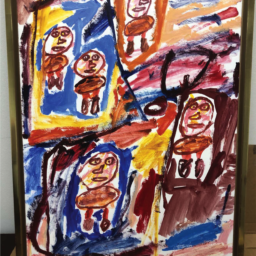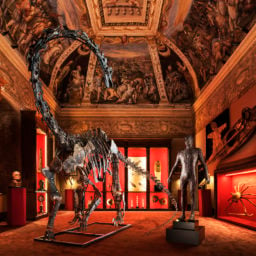Art Industry News is a daily digest of the most consequential developments coming out of the art world and art market. Here’s what you need to know this Wednesday, March 6.
NEED-TO-READ
Artist Accuses Tehran Museum of Wrongly Selling His Work – A growing number of artists are accusing the Tehran Museum of Contemporary Art in Iran of flipping their works for profit. Iranian artist Rokni Haerizadeh says that the institution acquired one of his works at a reduced rate and then sold it at auction for a premium. Tehran-based artist Barbad Golshiri also claims that his work is “missing” and that the museum will not confirm its whereabouts in writing. A former director of the museum says that works that were initially bought to support emerging artists may indeed have been sold years later. (The Art Newspaper)
Can This Computer Program Give Us New Insight Into Great Paintings? – Physicist Haroldo Ribeiro has digitally deconstructed paintings into numeric data and uploaded the nearly 140,000 digitized works to the encyclopedia WikiArt in order to chart trends in the development of different styles and gain insight into how different artistic periods evolved. Ribeiro and his team are using the metrics of physics to analyze the works, classifying them by “complexity” (the variation of patterns in the work) and “entropy” (how chaotic the image is). (Scientific American)
The World’s Greatest Art Thief Didn’t Do It for the Money – The notorious French art heist master Stéphane Breitwieser has stolen art from nearly 200 museums, pilfering works worth an estimated $1.4 billion combined. But in a wide-ranging interview with GQ, he says he didn’t do it for the money (particularly since stolen art is hard to sell). Instead, he describes his theft as a compulsion: He stole works that affected him emotionally. Breitwieser worked irregularly as a waiter while amassing a secret hideaway of treasures, including a snuffbox owned by Napoleon Bonaparte, a painting by Lucas Cranach the Younger, and works by Renaissance masters. Breitwieser was arrested in mid-February. (GQ)
Outcry Grows at Saudi Funding of Milan’s Opera House – As scrutiny grows in the art world over Saudi funding, the director of La Scala, Alexander Pereira, has defended his decision to accept €3 million ($3.4 million) a year over the next five years from the kingdom. The Saudi culture minister may even join the board. Pereira said he was aware of the “despotic” nature of the Saudi regime, but is convinced by the “positive force of music.” Critics have called the move a “slap in the face” for Milan and human rights. (AFP)
ART MARKET
To Vet or Not To Vet? Self-Policing at Fairs Faces Tough Questions – Change is afoot at TEFAF Maastricht, which opens March 16. The fair has made the decision that vetting should be carried out by experts who are as far away from the market as possible, removing dealers and auction-house representatives from the voting process. But the shift raises difficult questions about what really constitutes a conflict of interest; academics, curators, scientists, and scholars will have prejudices as well. (TAN)
Ghada Amer Joins Pilar Corrias –The Cairo-born artist is planning her first exhibition with the gallery in London in 2020. Corrias will also present Amer’s painting Rainbow Lulu at Art Basel Hong Kong later this month. The artist was previously represented by Cheim and Read, which recently shuttered its Chelsea gallery and moved into private practice. (Press release)
Lauren Halsey Wins the Frieze Art Award – The rising star artist will receive $25,000 from the prize funded by the Luma Foundation to create a new work for the upcoming edition of the Frieze Art Fair in New York. “The fair produces environments that can seem like worlds unto themselves,” Halsey said, “and I hope that this work will shift the visitor experiences in unexpected and meaningful ways.” (ARTnews)
COMINGS & GOINGS
Adam Szymczyk Gets a New Gig at Academy of Fine Arts Vienna – The former artistic director of documenta will lecture at the art academy until February 2020 while overseeing a project called “Principle of Equality—Open Studio.” The project, which will ruminate on freedom, includes an exhibition at the academy later on in the year. (ARTnews)
An All-Female Art Collective Will Direct Vienna’s Kunsthalle – A Croatian collective will take over the Austrian art hall, filling the vacancy left by highly regarded German curator Nicolaus Schafhausen, who is stepping down three years early this month due to what he describes as the country’s troubling political climate. The group of three women (a fourth member will remain in Zagreb) call themselves WHW, which stands for “What, How, and for Whom.” (OTS)
Michael Jackson Art Exhibition Will Still Travel to Germany – The Bundeskunsthalle in Bonn has confirmed it will open “Michael Jackson: On the Wall” as planned on March 22 despite the allegations of child sexual abuse that have resurfaced against the late pop star in the new documentary Leaving Neverland. The touring exhibition first opened at the National Portrait Gallery in London and contains work by more than 40 artists inspired by Jackson’s music, including Andy Warhol, Kehinde Wiley, and Faith Ringgold. (ARTnews)
Holograms Donated to the Getty – Collectors Guy and Nora Barron donated 105 glass plate holograms by 20 artists to the museum in Los Angeles. The artists, which include John Baldessari, Louise Bourgeois, and James Turrell, collaborated with holographers in the 1990s for an initiative called the C-Project. (Press release)
FOR ART’S SAKE
See a T-Rex in VR at the American Museum of Natural History – The New York museum has ramped up the volume for its Tyrannosaurus Rex show opening on March 11. Subtitled “The Ultimate Predator,” the show invites visitors to take part in a interactive, multi-player virtual reality experience. Working in a small team, they will be able to construct a T-Rex skeleton bone by bone in VR. The ferocious dinosaur then appears to “comes to life” in what is now Montana—its hunting ground 66 million years ago. (Designboom, New York Times)
A Mini-Version of Kapoor’s Bean Comes to New York – Ten years in the planning, a petite and squished version of Anish Kapoor’s shiny bean-shaped sculpture is due to be installed at the base of a swanky apartment building at 56 Leonard Street in Tribeca designed by Herzog and de Meuron. The sculpture gives the luxury tower some Chicago-style curb appeal, but as Gothamist notes, that curb is likely to be overrun by influencers posing for Instagram photo shoots in no time. (Gothamist)
This Is What Barbie Looks Like on Her 60th Birthday – The artist and illustrator Phaedra Peer has imagined what Barbie might look like if she were a real woman who hadn’t had any plastic surgery (or, you know, been made of plastic) to mark the doll’s 60th birthday. “We should be celebrating natural beauty,” Peer says, adding that the ageless Barbie isn’t a good role model. (Press release)

Barbie by artist Phaedra Peer.










